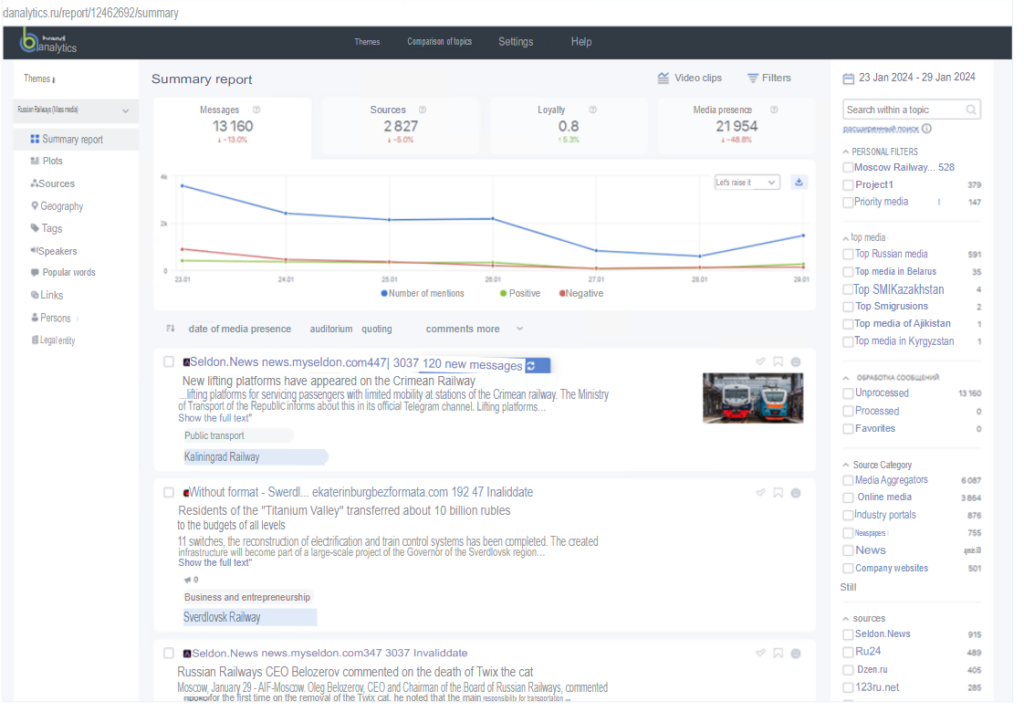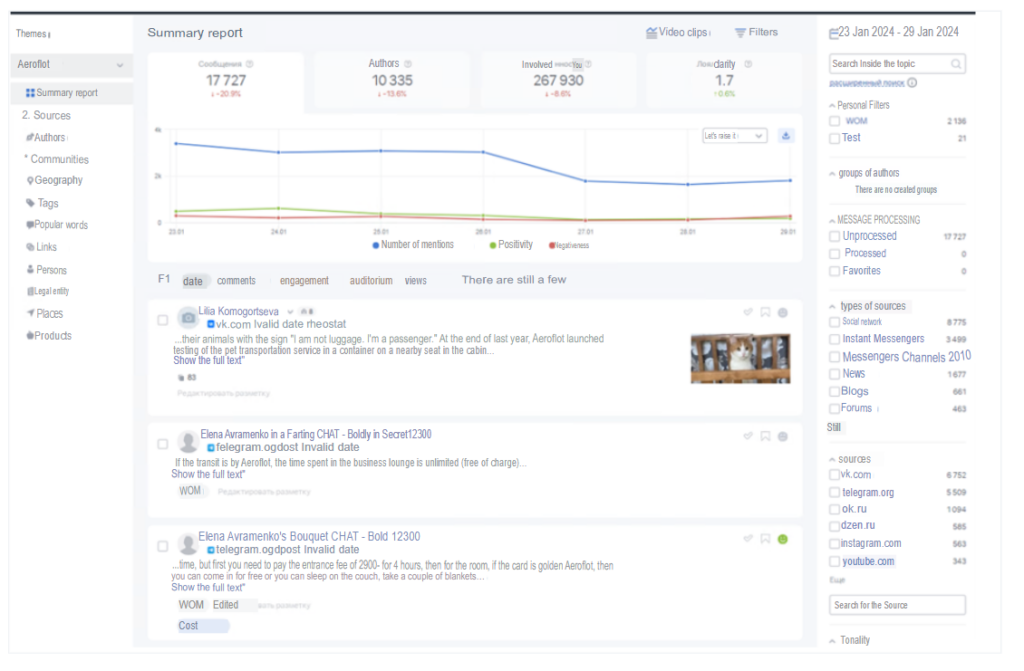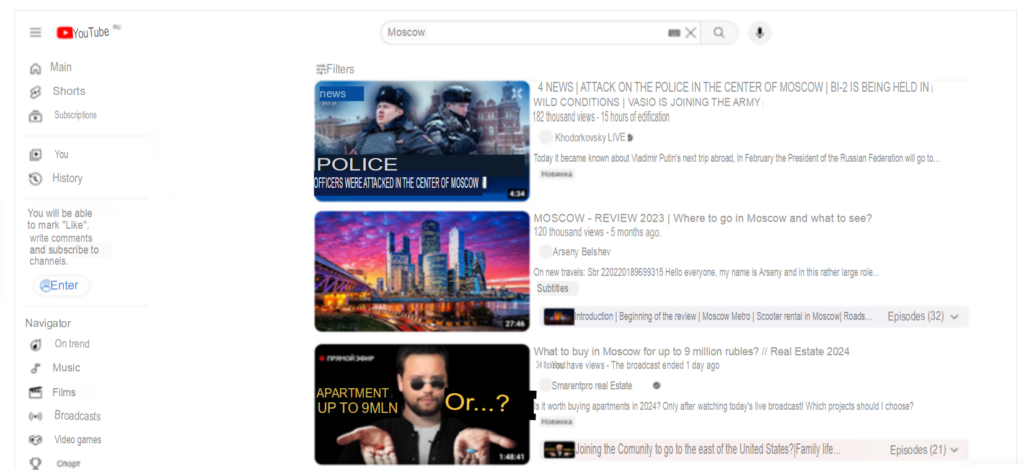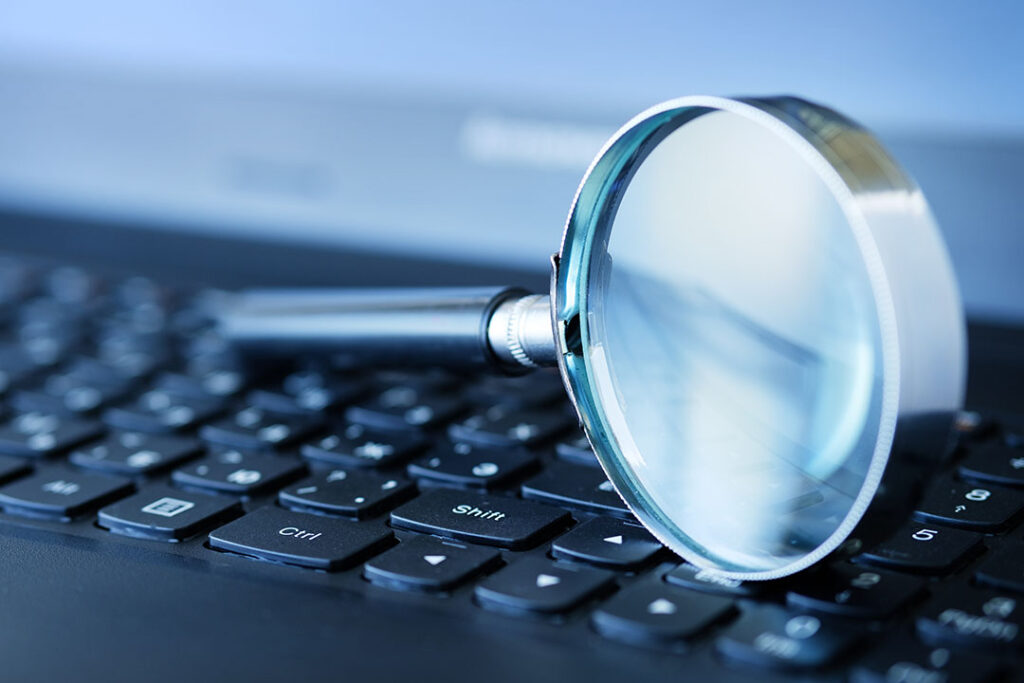In the world of digital transformation, where the influence of online presence becomes increasingly crucial for both business and personal reputation, understanding how you are perceived on the web becomes a key element in successfully engaging with your target audience. In this article, we will compare and contrast machine and human perception, explore the underestimated aspect of built-in search on social media, comprehend how to monitor the media, and answer the question, “How can monitoring generate leads?

Review monitoring on the Internet, automatic and manual. Machine vs Human.
In this section, we will delve into issues related to the monitoring system and analyze the automated and manual methods of this process. It is important to note that the boundaries between automated and manual monitoring can be quite blurred since the term “manual monitoring” often refers to systems that do not involve automation.
What is a monitoring system? It is a set of specialized services and programs designed to detect, organize, and analyze mentions of your reputation management object on the web. In reality, the monitoring process begins with reputation management and is carried out through systematic monitoring.
Where can you search for mentions of your brand? For example, in the absence of a monitoring system, you can start with manual searching, including the use of search suggestions. Enter the brand name, add keywords, and search for suggestions from various categories such as “Issues,” “Scandal,” “Horror,” “Nightmare,” “Conspiracy.” Although this method is labor-intensive, it can reveal negative sites and reputation issues.

However, for more effective monitoring, specialized services are required. Automated monitoring systems, such as Brand Analytics and Medialogia, allow for the quick and efficient collection of brand mentions. These tools conduct systematic analysis, and their actions are not limited to manual searches.
For those without access to paid monitoring systems, alternative methods exist, such as using Google Alerts and Yandex Blog Search. It’s also worth noting the built-in search functions in social media platforms like VKontakte, Odnoklassniki, and YouTube.
Let’s assume you are a young, progressive, and aggressive team, and it’s crucial for you to track mentions in real-time. Automated monitoring systems, such as Brand Analytics (which we will discuss in detail later), can be highly beneficial in this context, providing timely alerts, analytics, and thematic collection.

Thus, monitoring systems become an integral part of reputation management strategy, providing companies with the necessary tools for effective analysis and response to mentions on the web.
However, how can you assess the overall volume and origin of mentions about your brand? In this case, you can use publicly available tools such as Google Trends. This tool provides an interface where you can analyze trends in search queries. For example, by entering the name of a football club, you can obtain information about the dynamics of interest and geographical distribution.

Google Trends also provides the ability to compare brands by creating dynamic charts and maps that display the popularity of queries in different regions. This free tool can be useful for assessing overall interest in your brand and determining its popularity in various regions.
Thus, even without using paid monitoring systems, you can effectively measure interest in the brand and identify its geographical distribution.
Automated Monitoring
Let’s assume you represent a super-large brand of federal significance, such as Russian Post, Sberbank, or you represent a governmental structure, or an international brand entering the Russian market. You will be discussed by many, and you will likely need an automated monitoring system.
Why do we need an automated monitoring system? How to determine whether we need additional services or if we can rely on existing free tools on the internet?
Let’s try to assess the noise around your brand. To do this, we will use the Brand Analytics system. Visit their website and request access to the demo version. Enter the name of your brand, for example, “Aeroflot.” This brand is noisy, with many questions, complaints, and discussions. We see that in just one week, there are more than 17,000 mentions. This confirms that our brand is noisy, and simple search engines cannot process such a volume of data quickly and effectively.

In this screenshot, we see an interesting tool for monitoring mentions. Firstly, we notice the timeline displaying the dynamics of mentions over dates. Secondly, there are colored emojis (in this example, a green smiley). They indicate the sentiment of the mentions – neutral (blue), negative (red), and positive (green). This creates a visual message feed.
Additionally, we observe posts with photos, and the text is highlighted according to embedded keywords, allowing us to understand why these mentions stand out.
On the left is the analytics section, including sources, geography, authors, etc. This interface not only allows easy navigation and interaction with the data but also enables switching between different interface views.
Pay attention to the section on the top right, providing the option to change the monitoring period – from a day to a year. Large companies, such as Aeroflot or the Government of the Russian Federation, are recommended to use automated monitoring systems like Brand Analytics for efficient analysis of vast amounts of mentions.
Let’s take a closer look at another brand, for example, “S7 Airlines.” In a week, they have more than nine thousand mentions. This also indicates that for such noisy brands, additional tools are necessary. Assessing the noisiness of a brand is an important step in deciding on the need for an automated monitoring system.

Here is an informational summary based on primary data collected from mentions associated with the specified object. Let’s go through it, starting from the left and moving to the right.
- 9,607 – mentions in a week.
- 5,399 – unique authors. This is the number of users or accounts that discussed your reputation management object.
- 157,865 – engagement. This is the sum of likes, reposts, and comments.
- 0.8 – loyalty. This is the ratio of positive mentions to negative ones.
The monitoring system automatically performed this analysis. How can this be useful to us? Despite having preliminary marketing research, it is essential to determine whether we are being praised or criticized, whether the discussions about us are positive or negative.
To do this, let’s look at the main filters on the right. They significantly simplify information selection and help draw the necessary conclusions.

By examining sources, you can identify the platforms where you are most popular or, conversely, those that require further attention.
The Authors filter allows us to understand how many posts one author publishes about our brand. Significant growth may indicate the presence of brand enthusiasts or opponents who actively express their opinions.
Tags represent key topics in which the researched object is mentioned. Based on them, you can identify strengths and weaknesses and draw conclusions about what needs improvement and what should be addressed.
Sentiment analysis determines the tone in which mentions about you are expressed, as indicated by the previously mentioned emojis. It’s important to note that the system may not always accurately determine the positivity or negativity of a statement, but it provides enough information to draw the necessary conclusions.
Thus, by gathering all these filters for reputation management, we move on to the next stage of analysis.
Certainly, our primary task is to identify negative reviews to respond promptly. When a user expresses dissatisfaction, it’s crucial to provide assistance and determine the validity of their complaint. It’s important to discern whether it is genuinely a user in need of help or a troll. In the case of a genuine user, engaging in a dialogue, discussing the problem, and adhering to rules for handling negative situations are essential. Additionally, tracking positive brand mentions is equally important: liking, praising, and expressing gratitude create positive moments for customers.
Finally, we move on to regional analysis. The map shows which regions are discussing the brand. You can delve into each region to view more detailed statistics. This allows us to determine in which regions the brand is being discussed most actively.

Similarly, social projects can be analyzed, monitoring discussions on pensions, health, medical drugs, and even predicting potential epidemics by tracking mentions of symptoms such as cold or flu. This allows identifying regions where discussions on these factors become significantly active and taking appropriate measures.
Ultimately, the use of a monitoring system becomes an integral part of successful business management, enabling analyses, comparisons, and effective participation in social research.

Internal Search in Social Media
It’s important to remember that a search engine is not limited to standard search platforms like Yandex and Google. A search engine also encompasses platforms like YouTube, which has its own search functionality, and social networks such as VKontakte, and even Avito, where there is also a search tool. Wherever there is a search function, reputation management principles can be applied.
The built-in search mechanisms in popular social media are tools that are often underestimated, and many may not even be aware of their existence. Let’s explore the possibilities they offer and how monitoring systems can assist us in this.
Checking Reputation on VKontakte
VKontakte is one of the most widespread social networks in Russia, having been around for eighteen years. Its interface is familiar to almost all Russians. But do all users know about the full functionality of its search?
On the site, the search is located in the pinned header and can be accessed from any section. An example query could be related to searching for mentions of a company, for instance, Russian Post. The search results are presented in a feed of posts where the company is mentioned.

Equally interesting is the additional search function available in the side menu after the main search on VKontakte. Here, users can choose the type of messages, attachment type, number of likes, use geolocation, and exclude specific words from the search. A unique option is the ability to search for mentions of links. This can be useful, for example, to track reposts of an article on external platforms.
Moreover, the VKontakte tool allows searching through links to find where a particular article or material has been posted. This is valuable for reputation content analysis, monitoring discussions, and engaging with the audience. Users can quickly determine the context of mentions and, if necessary, interact with the community.
Thus, searching within social media, especially on VKontakte, provides rich functionality for analysis and interaction. Utilize these tools for more effective monitoring and engagement with your audience.
Checking Reputation on YouTube
Let’s consider an example on YouTube. When opening YouTube, we see the search bar. Even if entering a general topic query, such as “Moscow,” users may come across negative reviews or content. It is important to follow certain rules in this context.

The first step is to understand the legal aspects and rules of the platform itself. If there are grounds, attempt to remove the content and leverage digital jurisprudence.
The second step, if removal is not possible, is to create your own YouTube channel, optimize it, create playlists, and use the right keywords in the description.
The third step is to use paid advertising to have your content displayed at the top.
These steps are analogous to those used in dealing with search engines.
It’s important to understand that the methodology will vary for different platforms. Rules change, but general principles remain. Continuous monitoring and minimizing losses are the keys to success. Online reputation services do not guarantee the absolute disappearance of negative content, but they help minimize financial and reputational losses.
Remember, it’s crucial not to give up, reduce losses, and constantly work on minimizing customer attrition. This is a dynamic process, and the goal is not to achieve absolute perfection but to continuously improve and reduce missed opportunities.

Media Monitoring
Media monitoring is a comprehensive task that may pose challenges for beginners. Let’s briefly explore why media monitoring is necessary and how to make it more effective.
There are three crucial steps to consider when preparing for media monitoring:
- Define goals.
- Set tasks.
- Choose a suitable tool to achieve these goals and tasks.
When embarking on media monitoring, it’s essential to take into account several facts. For example, in Russia, according to Roskomnadzor’s data, there are currently 153,730 registered media outlets, and this is just the official figure. In reality, there are many more. Registered media outlets generate an incredible volume of messages every day. You will need to actively engage with this vast array of internet resources to find the information you need, gather it, analyze it, and draw conclusions.

Media Monitoring Tools: Beyond Basic Searches
When individuals first delve into media monitoring, they often resort to what is commonly referred to as “casual monitoring,” using search engines like Yandex or Google. While Google services do offer advanced features such as the Google Alerts notification system, their functionality is still limited.
Key drawbacks of such platforms include:
- Limited source base.
- High informational noise, complicating data processing.
- Lack of filtering options for geography, topics, sources, etc.
- Time-consuming.
In the Russian market, three main media monitoring systems prevail: SCAN, Medialogia, and Integrum. They all provide fundamental advantages that become apparent when the need for a professional system arises.
One of the key elements is the object-oriented search, allowing for quick filtration of irrelevant queries. For instance, SCAN can differentiate between different individuals with the same name and provides suggestions for more precise searches.
Professional systems also grant access to sources that are inaccessible in free resources. They possess a large and continuously updated source base. Additionally, there is a considerable group of sources not available to regular users, such as “Republic,” the channel “Dozhd,” and other professional resources.
Constant updating of the source base is as vital as the base itself. In paid systems, users gain access to dozens of tools and services necessary for media field analysis.
Professional systems enable a comprehensive audit of the media landscape concerning individuals, companies, or entire industries with just a few clicks. Competitive analysis, evaluating PR campaign effectiveness, and real-time monitoring of information activity all become swift and efficient. Analyzing a company’s reputation based on media sources becomes quick and effective.
When choosing a system, it’s crucial to pay attention to the volume and thematic focus of the loaded sources. The availability of closed sources is also important for a more thorough analysis. The decision to select a system should start with identifying your needs: assessing PR effectiveness, reputation analysis, or evaluating reputation risks. Specialized tools within the system should align with your specific tasks, whether it’s evaluating PR effectiveness or conducting a rapid analysis of reputation risks.
An essential factor is access to data not only from traditional media but also from social networks. Despite social networks being considered less significant for B2B companies, recent examples show their substantial impact on a company’s position. Systems that combine data from both traditional media and social networks are extremely valuable.

Sales: Monitoring and Lead Generation
Let’s discuss the importance of lead generation in monitoring systems—an interesting aspect that may seem unrelated to this context. What are we talking about? Let’s delve into it.
First and foremost, let’s focus on monitoring, which is currently at the center of our attention. We use these systems to collect, systematize, identify sources, and analyze reputation data. We actively explore who is searching for information about us, what is being published, where mentions are coming from, and the extent of coverage and engagement levels.
As we know, the primary goal of a commercial organization is to generate profit. But how do sales happen?
One way to promote products is through advertising. This is where contextual advertising comes into play, operating with existing demand. The user is looking for something specific, and advertising offers corresponding options.
There is also targeted advertising, which attempts to anticipate the user’s needs using data about their characteristics, such as gender, age, and location. Email campaigns are also employed, but they can be perceived as spam, causing dissatisfaction. Promotion using SEO optimization and Cost Per Action (CPA) payment systems are also methods of attracting customers.
However, let’s think about where those active searches are—the ones talked about so much in startup courses. People search for many things on their own, and our task is to help them find what they need.
Let’s analyze how many queries people make on their own using the internet. You can look at statistics, for example, using Yandex.Wordstat. It’s a free service that provides data on queries to find out how many users are searching for specific keywords. For example, the query “Where to buy?” could be a representative example.

More than 5.5 million queries. Somewhere among them are your customers. You just have to find them.
By conducting monitoring and tracking information about your brand, you can discover numerous interesting events. Keep an eye on your competitors and the industry as a whole. In the end, somewhere in the comments of articles or on forums, you may find messages from people looking for a product or service similar to yours. This, in turn, opens up opportunities for lead generation and active sales.

The screenshot shows an example of an already processed message from a potential customer. This task can be effectively solved by configuring the monitoring system, focusing it on the search for potential customers.
Users often express their needs, such as how to whiten teeth at home, prevent hair loss, or which face masks to use. This is an excellent opportunity to actively engage with the audience and offer products that solve their problems.
The proactive approach involves responding to such queries by providing solutions and products through comments. This not only opens up opportunities for sales but also creates a competitive advantage.
For example, if someone is looking for a car and requests a test drive, you can offer your services right in the comments. This individualized approach, where you come to the customer and provide them with a test drive, creates a unique customer-centric impression.
Creative approaches and monitoring queries allow not only reacting to customer needs but also actively promoting your services or products. For instance, if you notice queries about finding a beauty salon master, you can offer your services, attracting new customers.
The monitoring system can also be used to play on the negative aspects of competitors. By offering solutions and promotions, you can attract leads based on the shortcomings of competitors’ brands. This is an excellent way for active sales.
But how do you find these potential customers? The answer is to use various monitoring systems, such as Brand Analytics with brand analytics and the free Yandex Search for Blogs.
Let’s generate leads without an additional budget. Let’s go to Yandex blog search with the query “apartment for rent.”

Observe how people phrase this query and in what format. For instance, if we are a real estate agency, we can work with queries about renting apartments by offering our assistance.
Next, let’s consider another extensive business niche – car dealerships. This is a large segment where purchasing a car is a lengthy process.
A person wakes up in the morning, discusses their plans with family, relatives, and friends. The wife consults with the husband, colleagues exchange opinions, and this is an important part of our daily life. Nowadays, people also spend a lot of time on the internet, seeking advice from each other, looking for information, and searching for statistics on various matters, such as choosing a car.

Users actively seek advice, for example: “Recommend a car dealership: ru_avto-LJ (LJ stands for LiveJournal).” They express interest and await recommendations. It’s interesting to note that queries can be both anonymous and non-anonymous. An anonymous user can write in the comments, while a non-anonymous user may send a private message.

Also pay attention to the comments, perhaps a potential client is sitting there.
Here are a few recommendations for effective lead generation:
Defining the Region for Lead Generation:
- First and foremost, clearly define the geographical region in which your company is ready to provide its services. Consider the delivery system, which may not be adapted for all regions of Russia. Identify the areas where you can successfully operate.
Studying Industry Jargon:
- Familiarize yourself with the language specifics in your industry, as each business sector has its own stable expressions, terms, and slang. Understanding this terminology will not only facilitate lead search but also help interact more effectively with potential clients, taking into account their communication preferences.
Utilizing Influencers:
- Sometimes it is reasonable to involve influencers in your work. This can ensure more effective communication with the target audience and relieve you of the need to personally interact with clients. Place sales and support agents among influencers, allowing them to interact with potential clients based on their communication skills.
Prompt Response:
- It is crucial to respond promptly to inquiries and customer needs. Given that tens of thousands of users actively search for leads through various monitoring systems every month, the speed of response becomes a key factor for success. Don’t delay long responses, actively engage with potential clients, and don’t hesitate to initiate communication yourself.
Remember that a monitoring system is not only a tool for finding information about your brand but also a powerful tool for lead generation that can be used creatively and proactively. Be a pioneer in your industry, approach lead search intelligently, and use the monitoring system for active sales.

In Conclusion
We can see that online reputation monitoring is an integral tool for successful business management and maintaining a personal image in the digital era. Strategies based on regular reviews analysis, content management, and effective audience interaction not only prevent potential crises but also create a favorable perception. Remember: your online reputation is your digital business card, and careful monitoring ensures its continuous improvement. Pay attention to your online image, utilize monitoring and reputation management tools ––– and make a positive impression in the virtual world.
If you need support in SERM / ORM, simply leave us a request in the form below. We guarantee to find an optimal solution that meets your needs.

0 Comments on "Monitoring reviews and reputation in the Russian segment of the Internet"